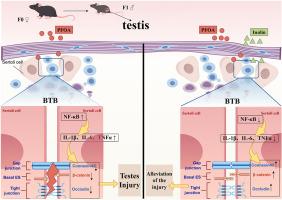早期PFOA暴露诱导的男性生殖不良反应与NF-κB信号通路的激活有关:菊粉的缓解作用
IF 3.5
3区 医学
Q2 FOOD SCIENCE & TECHNOLOGY
引用次数: 0
摘要
全氟辛酸(PFOA)广泛分布于各种环境介质中,对健康有不利影响。PFOA对男性生殖系统发育毒性影响的潜在机制尚不清楚。本实验以8周龄C57BL/6 J雌性小鼠为研究对象,从妊娠第1天至断奶,分别灌胃milliq水、PFOA (1 mg/kg/d)、PFOA加菊粉(5 g/kg/d)或菊粉,观察PFOA对雄性后代生殖功能的影响。生命早期接触全氟辛酸会导致精子质量和睾丸激素水平下降,睾丸结构受损,表明对生殖有不利影响。转录组学分析显示,PFOA组睾丸经KEGG富集分析,NF-κB通路富集。p-p65与p65的蛋白表达比下降(p-p65/p65)提示NF-κB信号通路受到干扰。菊粉可减轻早期PFOA暴露引起的睾丸结构损伤,提高精子质量和睾酮水平,降低p-p65/p65比值的蛋白表达。综上所述,我们的研究结果表明,生命早期暴露于PFOA可能通过激活NF-κB信号通路破坏睾丸血睾丸屏障的完整性,从而对男性生殖产生不利影响,菊粉干预可以减轻这种影响。本文章由计算机程序翻译,如有差异,请以英文原文为准。

Early-life PFOA exposure-induced male reproductive adverse effects are associated with the activation of the NF-κB signaling pathway: The mitigative role of inulin
Perfluorooctanoic acid (PFOA) is widely distributed in various environmental media and has adverse health effects. The underlying mechanisms of the effects of PFOA on the developmental toxicity of the male reproductive system are poorly understood. In this study, 8-week-old C57BL/6 J female mice were given Milli-Q water, PFOA (1 mg/kg/day), PFOA and inulin (5 g/kg/day) or inulin by gavage from the first day of pregnancy until weaning to evaluate the effects of PFOA on the reproductive function of male offspring. Early-life PFOA exposure resulted in decreased sperm quality and testosterone levels, impaired testicular structure, suggesting adverse reproductive effects. According to the transcriptomics analysis, the NF-κB pathway was enriched by KEGG enrichment analysis in the testes of the PFOA group. Consistently, the decreased protein expression ratio of p-p65 to p65 (p-p65/p65) suggested disturbance of the NF-κB signaling pathway. Inulin alleviated testicular structure injury resulting from early-life PFOA exposure, increased sperm quality and testosterone, and decreased the protein expression of the p-p65/p65 ratio. Taken together, our results suggested that early-life PFOA exposure might disrupt the integrity of the blood‒testicular barrier in the testis by activating the NF-κB signaling pathway, resulting in adverse male reproductive effects, which were alleviated by inulin intervention.
求助全文
通过发布文献求助,成功后即可免费获取论文全文。
去求助
来源期刊

Food and Chemical Toxicology
工程技术-毒理学
CiteScore
10.90
自引率
4.70%
发文量
651
审稿时长
31 days
期刊介绍:
Food and Chemical Toxicology (FCT), an internationally renowned journal, that publishes original research articles and reviews on toxic effects, in animals and humans, of natural or synthetic chemicals occurring in the human environment with particular emphasis on food, drugs, and chemicals, including agricultural and industrial safety, and consumer product safety. Areas such as safety evaluation of novel foods and ingredients, biotechnologically-derived products, and nanomaterials are included in the scope of the journal. FCT also encourages submission of papers on inter-relationships between nutrition and toxicology and on in vitro techniques, particularly those fostering the 3 Rs.
The principal aim of the journal is to publish high impact, scholarly work and to serve as a multidisciplinary forum for research in toxicology. Papers submitted will be judged on the basis of scientific originality and contribution to the field, quality and subject matter. Studies should address at least one of the following:
-Adverse physiological/biochemical, or pathological changes induced by specific defined substances
-New techniques for assessing potential toxicity, including molecular biology
-Mechanisms underlying toxic phenomena
-Toxicological examinations of specific chemicals or consumer products, both those showing adverse effects and those demonstrating safety, that meet current standards of scientific acceptability.
Authors must clearly and briefly identify what novel toxic effect (s) or toxic mechanism (s) of the chemical are being reported and what their significance is in the abstract. Furthermore, sufficient doses should be included in order to provide information on NOAEL/LOAEL values.
 求助内容:
求助内容: 应助结果提醒方式:
应助结果提醒方式:


